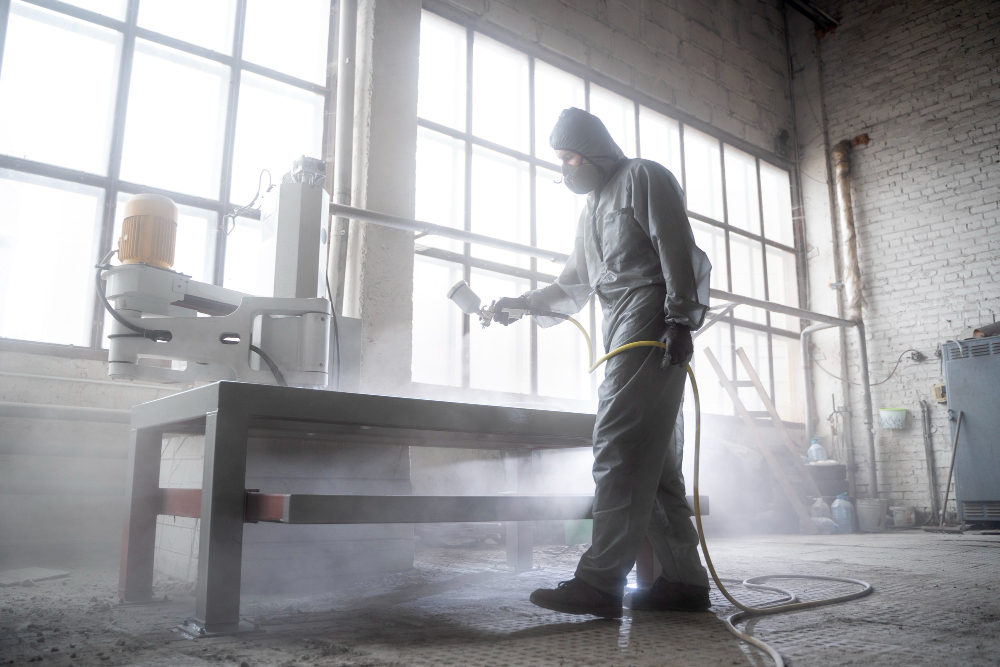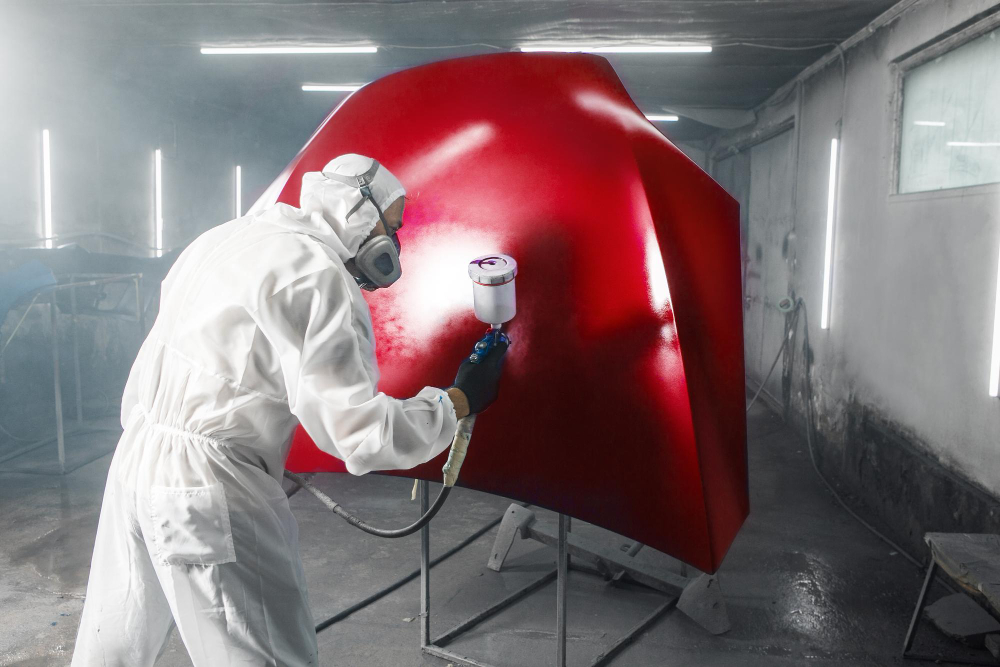Supporting the automotive, aerospace, electronics, packaging, and construction industries, the coating and paint business is an essential sector. In addition to being aesthetically pleasing, coatings offer defense against environmental harm, wear, and corrosion. The industry faces several chemical, environmental, and occupational risks despite its vital role. There are several hazards associated with the production, handling, and application of paint and coatings, ranging from hazardous pigments to volatile solvents, necessitating strict safety precautions.
With an emphasis on health effects, chemical hazards, fire risks, environmental issues, and mitigation techniques, this blog examines the many risks and hazards related to the paint and coating industry.
1. Overview of the Coating and Paint Industry
Resins, pigments, solvents, and additives are among the raw ingredients used in the manufacture and application of paints and coatings. Before being delivered to final consumers, these materials go through processes of mixing, dispersion, milling, and packing.
Coating types include:
- Paints based on solvents
- Paints that are based on water
- Coatings made of powder
- UV-curable paints
- Industrial coatings with high performance (epoxy, polyurethane, etc.)
Various types present distinct risks based on their chemical makeup and mode of application.
2. Chemical Hazards
Volatile Organic Compounds (VOCs)
Organic compounds that are volatile (VOCs)
Many liquid and solid materials used in coatings release volatile organic compounds (VOCs) as gasses. These consist of solvents such as methyl ethyl ketone (MEK), acetone, xylene, and toluene.
VOCs provide two main dangers:
Health risks: Long-term exposure may result in cancer or harm to the liver and kidneys, and inhalation may induce headaches, dizziness, and respiratory irritation.
Air pollution: VOCs help create smog and ground-level ozone, which have wider effects on the environment and human health.
Heavy Metals and Pigments
Pigments and Heavy Metals
Certain colors and additives may include dangerous ingredients such as:
- Chromate of lead
- Compounds containing cadmium
- VI, or chromium
Children who are exposed to these substances, even in trace amounts, may experience developmental delays, kidney problems, or brain harm. Lead-based paints may still be utilized in industrial settings or in areas with less stringent restrictions, even though many nations have phased them out.
Isocyanates
Isocyanates are extremely reactive substances used in polyurethane coatings that might result in:
- Extreme inflammation of the skin and respiratory system
- Asthma at work
- Sensitization (which, after repeated exposure, results in persistent intolerance)
Working with items that include isocyanate requires careful handling and personal protective equipment (PPE).
3. Fire and Explosion Hazards
Flammability of Solvents
The capacity of solvents to ignite
Numerous solvents used in the manufacturing of paints and coatings have low flash points and evaporate rapidly, producing fumes that are extremely flammable. There is a significant chance of fire or explosion when paired with ignition sources (such as sparks, open flames, static discharge, or even electrical switches).
Typical combustible materials:
- Naphtha
- Toluene
- Acetone
- Alcohol
Among the high-risk locations are mixing rooms:
- Booths for spraying
- Tanks for storage
In these settings, proper ventilation, grounding, and explosion-proof equipment are crucial.
Dust Explosions
Fine powder particles in the air might create explosive clouds during powder coating activities. These clouds can produce destructive explosions if they catch fire. Mechanical friction, static electricity, and poor housekeeping can all serve as sources of ignite.
4. Occupational Health Hazards
Inhalation Risks
Paint products that are sprayed, mixed, and sanded emit dust, fumes, and vapors into the atmosphere. Workers risk breathing in dangerous substances if they don't have the right ventilation and respiratory protection. Prolonged exposure can result in:
Having asthma
Prolonged bronchitis
Cancer of the lung
Disorders of the nervous system
Chemicals that irritate or sensitize skin are present in many coatings. Extended or frequent skin exposure can result in:
- Dermatitis in contact
- Burns from chemicals
- Reactions to allergens
Skin exposure can be reduced by using barrier lotions, gloves, and protective garments.
Eye Hazards
Eye injuries can result from airborne dust particles, chemical fumes, or solvent splashes. Among the possible outcomes are:
- Chemical ocular irritation
- Burns to the cornea
- impairment of vision
In these situations, safety eyewear or face shields are required PPE.
5. Ergonomic and Physical Hazards
Employees in the paint and coating sector frequently experience physical strain as a result of manual handling of heavy containers, difficult postures, and repeated jobs. Typical problems include:
- Disorders of the musculoskeletal system
- Back injuries
- fatigue brought on by extended standing or working in shifts
These dangers can be reduced by using lifting aids, taking regular rests, and designing workstations with ergonomics in mind.
6. Environmental Hazards
Air Pollution
Both indoor and outdoor air quality can be impacted by the emission of volatile organic compounds (VOCs), solvent vapors, and particle matter. Scrubbers, carbon filters, and well-ventilated spaces are required for emissions management in paint manufacturing and application facilities.
Water and Soil Contamination
Water supplies and soil can get contaminated when paint residues, wash water, or solvent waste are improperly disposed of. The risk is increased by spills or leaks that occur during storage or transit.
Waste management procedures and wastewater treatment systems are essential for reducing environmental damage.
7. Noise and Heat Hazards
Over time, excessive noise levels from conveyor systems, compressors, and mixers can cause hearing loss. Similarly, workers may be exposed to high heat in curing ovens and spray booths, which raises the possibility of burns, dehydration, and heat stress.
It is crucial to use hearing protection and control the temperature in work settings.
8. Regulatory Compliance and Standards
Globally, the paint and coatings business is governed by stringent safety and environmental laws. Among the important regulatory frameworks are:
Occupational Safety and Health Administration (OSHA) in the United States.
The United States Environmental Protection Agency, or EPA.
Regulation, Assessment, Permission, and Control of Substances (REACH): EU
India's Hazardous Chemical Regulations and Factory Acts
The Globally Harmonized System (GHS) is used to classify and label substances.
Adherence to these rules facilitates:
- Safe handling and labeling of dangerous substances
- Employee education and training
- Tracking and disclosing waste and emissions
9. Safety Management and Best Practices
Risk Assessments
Every operation, including the storage, mixing, packing, and application of raw materials, should undergo routine hazard identification and risk assessment.
Personal Protective Equipment (PPE)
Essential PPE includes:
- Respirators and masks
- Gloves and coveralls
- Eye protection
- Flame-resistant clothing
Ventilation and Containment
By using enclosed spray booths, fume hoods, and local exhaust ventilation (LEV), workers can avoid breathing in dangerous dust and fumes.
Fire Safety Protocols
Facilities need to be furnished with:
- Fire extinguishers, particularly those classified as Class B for flammable liquids
- Flame sensors
- Sprinkler systems
- Electrical equipment that is resistant to explosions
Regular fire drills and emergency evacuation plans are essential elements of fire safety.
Training and Awareness
Frequent training sessions on emergency protocols, chemical handling, spill response, and material safety data sheets (MSDS) strengthen safety cultures and lower accident rates.
10. Future Trends and Safer Alternatives
As the industry moves toward sustainability, several safer alternatives and technologies are gaining ground:
- Water-based paints: Lower VOC emissions
- High-solids and powder coatings: Reduced solvent use
- Bio-based resins and pigments: Eco-friendly ingredients
- Smart coatings: With self-healing and anti-corrosive properties, reducing maintenance risks
Innovation and environmental consciousness are paving the way for a safer, cleaner paint industry.


